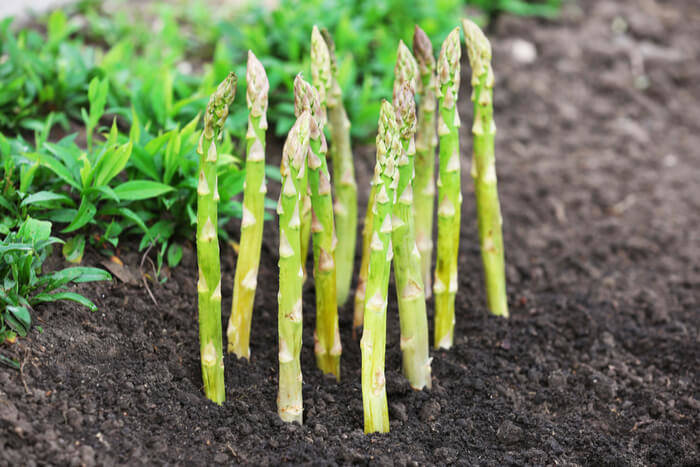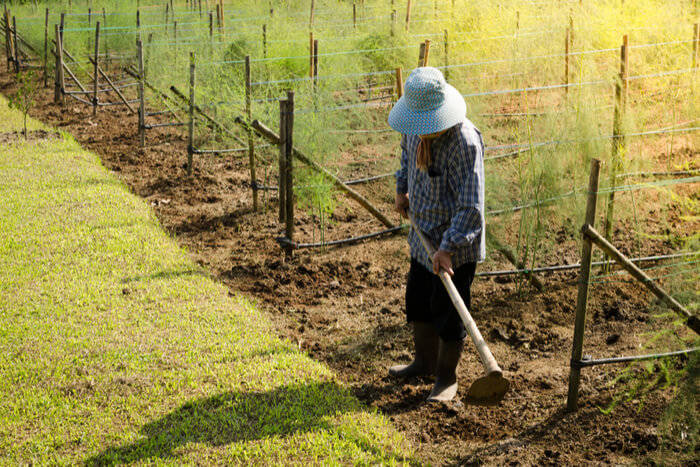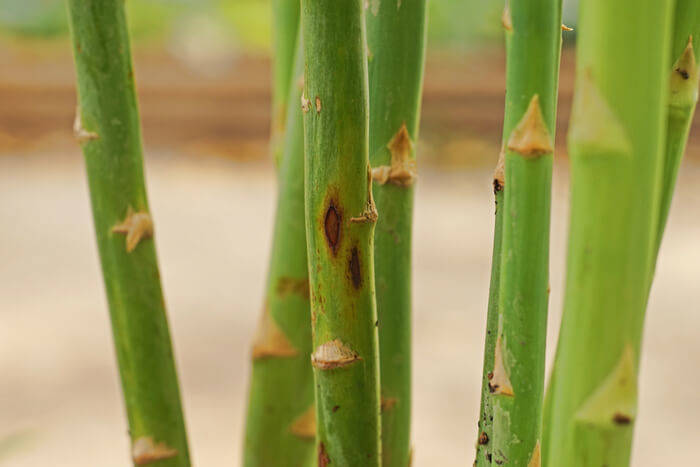So, you want to grow some asparagus because you like the way it tastes. Who doesn’t? Unfortunately, this vegetable is not as easy to grow as it looks. Fortunately, if you persevere, you will have a delicious perennial vegetable gracing your garden year after year. What a reward!

Not to mention that edibles from your own yard taste much better than anything you could buy from the store. In this article, we will walk you through how to grow asparagus from crowns. You will be much more confident by the time you’re through.
Easiest Varieties of Asparagus
If you are new to growing this delectable delight, you probably want to try the most simple to grow types. The following is a list of popular choices by other aspiring asparagus gardener:
- Purple Passion
- Brock Imperial
- Princeville
- Jersey Knight (most common)
- Jersey Giant (most common)
- Mary Washington (most common)
Remember, if you want to have larger stalks buy male plants. The females focus on producing seeds while the other focuses all of its energy on bulk. For a family of 4, you are going to want to have 25 plants on hand for enough asparagus to last all year!
Choose the Area
When deciding the amount of space you need for these plants, find out how big your chosen variety can get. Most asparagus plants will grow to the mature size of 5 feet tall and 3 feet wide. That’s actually quite large, considering the edible stalks are only 6 to 8 inches in length.
When looking for the perfect place to plant, decide on a location that gets full sunlight. A good amount of daily sun is important to this vegetable. Without it, the spears will be small and weak. Worse, the whole unit could become compromised by disease.

The most important thing to remember when picking out an area is to realize that you have a perinneal plant. Moreover, asapargus live for 20 years. That means you are going to have to till around a patch of your garden for the next 20 years. Choose wisely.
Prepare the Area
Before planting, there are a variety of things you should do to prepare the area. The first is enriching the soil. This type of vegetable loves a neutral pH between 6 and 7. Make sure to add in some compost or other organic matter to give the soil enough nutrients.
In addition to adding something to soil, you need to take something away. Get out any leftover rocks, sticks, and other debris crowding your plant’s future home. Hey, you were the ones that wanted to know how to grow asparagus!
Planting Crowns
You will want to dig some trenches. Each must be at least 8 inches below ground and 12 inches across. If you have sandy soil, you will need to dig down to 10 inches in the soil. Leave 2 feet between trenches for the crowns to grow into. Put a couple inches of dirt on top, and water.
Asparagus Maintenance
As the crowns turn into plants, they will grow. As they grow, continue to cover them with soil leaving only a few inches visible. This helps keep weeds at bay and roots to establish faster. When the trench is full, you can stop adding soil. However, continue to add 2 inches of mulch.

When your plants are young, they need a lot of water. After the 2-year mark, they are big enough to back off of the regular watering. Fertilize your plants in both the autumn and the spring. Before spring, remove and destroy any of the foliage to reduce the risk of diseases.
Another word about maintenance involves dreaded weeds. If you are keeping 2 inches of mulch above soil level, weeds will have a difficult time germinating. As a warning, you should remove these pesky plants sooner than later. Asparagus roots are a mess to detangle from weed roots.
Watch for Insects and Disease
In general, asparagus is a vegetable with very little issues. The worst insect is the asparagus beetle. Look for these guys in spring and summer. When you see a few dark eggs, hand pick them off. If you have more than a few, go to your nearest garden center and buy some neem.
Two other foliage-devouring pests are the asparagus miner and the 12-spotted asparagus beetle. If you find of the miner’s zig-zag tunnels on your stalks, destroy any infested fern foliage. Destroy the beetle with insecticidal soap.
Another issue that can strike older asparagus plants is fusarium. The name sounds funny, but it is a very big problem. Fortunately, you can prevent fusarium by choosing a variety bred to be resistant to the disease.

Realistic Expectations
The worst thing about growing asparagus from scratch is the wait. It takes 3 full years to get the girthy, flavorful spears you want so badly. However, once you do you will have enough asparagus to last the whole year through. You may have to take up canning!
In the first year, the shoots will grow but won’t be very big. The plant is trying to establish itself. The second year, you may be able to eat a few of the veggies in an initial harvest. However, the unit would do better focusing all of its attention of growth. In the third year, you can feast!
Harvest Time
When you are lucky enough to reach your 3rd year, you get to harvest your hard-earned asparagus. To cut, simply snap them or cut them with a knife right below the soil. Just be careful to watch out for new shoots only appearing. Now, celebrate by making a delicious meal in your log cabin.

When you do get a batch, you will be able to get a month straight harvest! After year 3, you should harvest for 2 months or until the shoots start looking bad. Then, give the plant some time to grow some beautiful fern-like foliage. This gives the roots something to feed off of.




